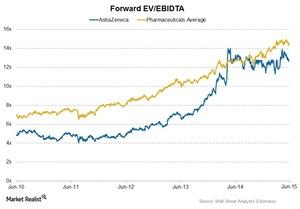AstraZeneca’s Position Compared to Its Peers
The forward EV/EBIDTA multiple for AstraZeneca is ~13x, which is slightly lower than the industry average of ~14x.
June 25 2015, Updated 11:05 a.m. ET

AstraZeneca as compared to its peers
AstraZeneca (AZN) is focused on prescription drugs in the worldwide market. Its competitors in biopharmaceuticals include Merck and Co. (MRK), Novartis AG (NVS), GlaxoSmithKline (GSK), Pfizer (PFE), and Teva Pharmaceuticals (TEVA).
Pharmaceuticals and healthcare companies are capital-intensive companies, and they have high levels of debt on their balance sheets due to heavy setup costs and huge research and development expenses. The EV/EBITDA (or enterprise value to earnings before interest, tax, depreciation, and amortization) ratio is often used to value capital-intensive companies. The above chart shows the forward enterprise multiple (or forward EV/EBIDTA multiple) trend over the past five years for AstraZeneca along with the change in its EBIDTA margin.
EV/EBIDTA multiple
The forward EV/EBIDTA multiple for AstraZeneca is ~13x, which is slightly lower than the industry average of ~14x. Industry peers Johnson and Johnson (JNJ), Merck and Co. (MRK), Eli Lily and Co. (LLY), and Bristol Myers Squibb (BMY) have enterprise multiples of ~11x, ~12x, ~17x, and ~24x, respectively.
PE multiple
The price-to-earnings (or PE) multiple is one of the simplest multiples used for valuations. A forward PE multiple is the estimated PE multiple for the next 12 months. The forward PE ratio for AstraZeneca is estimated at around 15.9x for 2015, while it is expected to be around 18.8x for the industry. It is clear from the cross sectional study that EPS (earnings per share) growth does not have any impact on the forward PE of AstraZeneca.
ETFs like the Health Care Select Sector SPDR ETF (XLV) and the iShares US Healthcare ETF (IYH) are focused on pharmaceutical companies.
